Softbank and Nvidia make further progress with vRAN accelerationSoftbank and Nvidia make further progress with vRAN acceleration
Japanese telco Softbank this week served up more evidence of how graphic processing units (GPUs) can do some of the heavy lifting in virtualised radio access networks (vRAN).
March 22, 2023

Japanese telco Softbank this week served up more evidence of how graphic processing units (GPUs) can do some of the heavy lifting in virtualised radio access networks (vRAN).
Together with chip maker Nvidia – which as anyone familiar with PC gaming knows is one of, if not the biggest name in the GPU market – the company on Wednesday demonstrated an image processing application running in a multi-access edge computing (MEC) environment on a vRAN augmented with a GPU.
In the demo, carried out at Softbank’s AI-on-5G Lab, a 5G connected camera sent images to an edge application that used AI to detect people in real time. In addition to Nvidia, Softbank also worked with virtualised network software provider Mavenir, and hardware maker Foxconn.
To work efficiently, apps like this not only require a high-speed, low-latency connection, but also fast processing, which is where the GPU comes in.
Unlike a general purpose processor (GPP), which is designed to a be a jack-of-all trades, GPUs are designed specifically for compute-heavy workloads. They are also designed to be installed in commercial off-the-shelf (COTS) hardware, like servers and desktop PCs, lending themselves well to cloud-based network architecture. Furthermore, companies like Nvidia have the capacity to produce GPUs at scale, making them viable for widespread deployments.
“Softbank has been working on ways to share resources with several applications using GPUs, even though many vRAN accelerators are specialised for vRAN software. This achievement proves GPUs are usable with both RAN and AI applications,” said Softbank, in a statement, adding that it plans to push ahead with using them at MEC locations on its vRAN.
Meanwhile, Softbank has also been getting to grips with delivering cellular connectivity to low-altitude aircraft like helicopters and drones.
In a separate statement, it revealed that it is working with German in-flight connectivity specialist SkyFive to verify signal propagation characteristics in what it calls the “airspace environment”.
It’s an important area of research, given the amount of interest in connected drones in particular. Recent highlights include Telefónica conducting a 5G drone delivery demonstration, and BT investing £5 million into Unified Traffic Management (UTM) software firm Altitude Angel as part of ‘Project Skyway’, the UK’s drone superhighway.
“On the ground, radio waves are sometimes blocked by buildings and trees, but in the sky, there are virtually no obstacles and radio waves can reach farther. As a result, interference with radio waves emitted from neighbouring base stations increases, causing a deterioration of reception quality and a reduction in communication speeds,” Softbank explained.
“In addition, the movement speeds of communication terminals carried by drones and other aerial mobility devices is faster than those of smartphones and other devices used on the ground. This can cause a phenomenon in which the frequency is observed as a value differing from what it actually is (Doppler shift), or the reception level of radio waves fluctuates (fading), resulting in fluctuations in reception power and communication quality,” it said.
In February, Softbank and SkyFive carried out tests in Germany that saw a base station on the ground connect via 2-GHz spectrum to a terminal installed on a crewed aircraft in the sky above. Flights were conducted at various altitudes and speeds in order to simulate various use cases, and the signal propagation characteristics were recorded.
“This data will enable the prediction of communication quality in the airspace and will be useful for the optimal design and formation of networks,” Softbank said. “Softbank expects that the data obtained from this verification will be useful in designing airspace communication networks that provide stable communication speeds and capacity.”

Get the latest news straight to your inbox. Register for the Telecoms.com newsletter here.
About the Author
You May Also Like










.png?width=300&auto=webp&quality=80&disable=upscale)


_1.jpg?width=300&auto=webp&quality=80&disable=upscale)